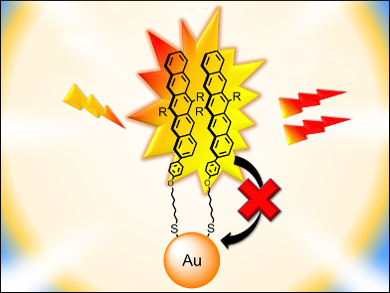Nikolai V. Tkachenko, Taku Hasobe, and a team at Keio University, Japan, and Tampere University of Technology, Finland, have reported the formation of self-assembled pentacene monolayers on metal nanoparticles (MNPs). What is special about these structures is that the monolayers have long-lived excited triplet states with high quantum yields.
Three-dimensional self-assembled monolayers of organic dyes on MNPs represent a new generation of photofunctional nanomaterials. However, a serious drawback is the significant deactivation pathway between the dyes and the metal surface. The researchers overcame this problem by designing gold nanoparticles protected by triisopropylsilyl (TIPS) groups or pentacene–alkanethiolate monolayers with different chain lengths and particle sizes.
Triplet excited states of pentacenes were generated by singlet fission, where one singlet exciton splits into two triplet excitons, and energy transfer to the gold surface is suppressed. Photophysical measurements showed that triplet states with high quantum yields (172 ± 26 %) were formed. These systems have potential applications in light energy conversion and optical molecular rulers.
- High-Yield Excited Triplet States in Pentacene Self-Assembled Monolayers on Gold Nanoparticles through Singlet Exciton Fission,
Daiki Kato, Hayato Sakai, Nikolai V. Tkachenko, Taku Hasobe,
Angew. Chem. Int. Ed. 2016.
DOI: 10.1002/anie.201601421



